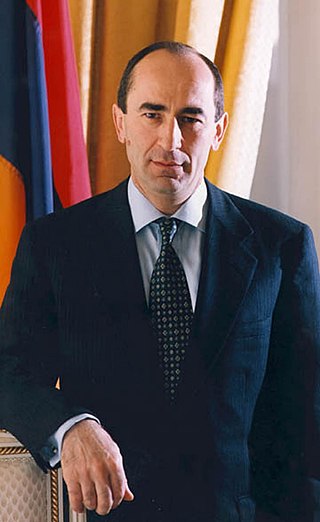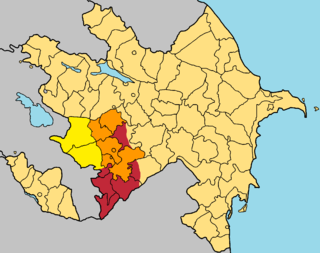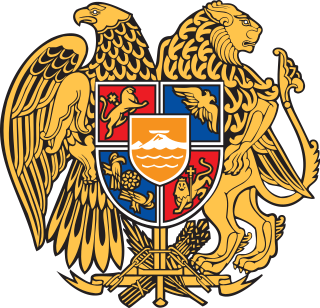
Nagorno-Karabakh is a region in Azerbaijan, covering the southeastern stretch of the Lesser Caucasus mountain range. Part of the greater region of Karabakh, it spans the area between Lower Karabakh and Syunik. Its terrain mostly consists of mountains and forestland.

Robert Sedraki Kocharyan is an Armenian politician. He served as the President of the Nagorno-Karabakh Republic from 1994 to 1997 and Prime Minister of Nagorno-Karabakh from 1992 to 1994. He served as the second President of Armenia between 1998 and 2008 and as Prime Minister of Armenia from 1997 to 1998.

Artsakh, officially the Republic of Artsakh or the Republic of Nagorno-Karabakh, was a breakaway state in the South Caucasus whose territory was internationally recognised as part of Azerbaijan. Between 1991 and 2023, Artsakh controlled parts of the former Nagorno-Karabakh Autonomous Oblast of the Azerbaijani Soviet Socialist Republic, including its capital Stepanakert. It had been an enclave within Azerbaijan from the 2020 Nagorno-Karabakh war until the 2023 Azerbaijani offensive, when the Azerbaijani military took control over the remaining territory controlled by Artsakh. Its only overland access route to Armenia after the 2020 war was via the five kilometres (3.1 mi)–wide Lachin corridor, which was placed under the supervision of Russian peacekeeping forces.

The First Nagorno-Karabakh War was an ethnic and territorial conflict that took place from February 1988 to May 1994, in the enclave of Nagorno-Karabakh in southwestern Azerbaijan, between the majority ethnic Armenians of Nagorno-Karabakh backed by Armenia, and the Republic of Azerbaijan with support from Turkey. As the war progressed, Armenia and Azerbaijan, both former Soviet republics, entangled themselves in protracted, undeclared mountain warfare in the mountainous heights of Karabakh as Azerbaijan attempted to curb the secessionist movement in Nagorno-Karabakh.
The OSCE Minsk Group was created in 1992 by the Conference on Security and Cooperation in Europe (CSCE), now Organization for Security and Co-operation in Europe (OSCE), to encourage a peaceful, negotiated resolution to the conflict between Azerbaijan and Armenia over Nagorno-Karabakh.

The Nagorno-Karabakh conflict is an ethnic and territorial conflict between Armenia and Azerbaijan over the region of Nagorno-Karabakh, inhabited mostly by ethnic Armenians until 2023, and seven surrounding districts, inhabited mostly by Azerbaijanis until their expulsion during the 1990s. The Nagorno-Karabakh region was entirely claimed by and partially controlled by the breakaway Republic of Artsakh, but was recognized internationally as part of Azerbaijan. Azerbaijan gradually re-established control over Nagorno-Karabakh region and the seven surrounding districts.

The following outline is provided as an overview and topical guide of the Republic of Artsakh and Nagorno-Karabakh region:
This page lists in alphabetical order articles related to the Republic of Artsakh and Nagorno-Karabakh region. For a topically arranged list of articles, please see Outline of the Republic of Artsakh.

The Constitution of the Republic of Artsakh was the basic law of the Republic of Artsakh. It was approved by the people of Artsakh in a referendum that was held on 20 February 2017. It superseded the constitution previously ratified by the people in 2006. Over 76.5% of the electorate participated in the 2017 referendum. Of these, over 90% voted for its adoption, with just under 10% voting against its adoption. This constitution proclaimed the Nagorno-Karabakh Republic to be a sovereign, democratic state that was based on social justice and the rule of law. The constitution stated that the names "Republic of Artsakh" and "Republic of Nagorno-Karabakh" were synonymous. The constitution affirmed that all power is vested in its citizens, who exercise it directly through constitutional referendums and indirectly through their elected representatives. Proposed changes to the constitution or to an alteration of the borders of the State had to be ratified by the people in a referendum. Stepanakert was defined as the state's capital. As a result of the Azerbaijani offensive, the constitution was repealed when on 28 September 2023, the president of Artsakh subsequently signed a decree to dissolve all of the republic's institutions by 1 January 2024, under article 93, bringing its existence to an end.

The Madrid Principles were proposed peace settlements of the Nagorno-Karabakh conflict, proposed by the OSCE Minsk Group. The OSCE Minsk Group was the only internationally agreed body to mediate the negotiations for the peaceful resolution of the conflict prior to the renewed outbreak of hostilities in 2020. Senior Armenian and Azerbaijani officials had agreed on some of the proposed principles but made little or no progress towards the withdrawal of Armenian forces from occupied territories or towards the modalities of the decision on the future Nagorno-Karabakh status.

An independence referendum was held in the Armenia SSR on 21 September 1991 to determine whether to secede from the Soviet Union. It followed a declaration of independence on 23 August 1990. 99.5% of voters voted in favour, with a turnout of 95%. The country officially became an independent state on 23 September 1991.

The Law on Abolishment of Nagorno-Karabakh Autonomous Oblast was a motion passed by the Supreme Soviet of the Republic of Azerbaijan and signed into law by the President of Azerbaijan Ayaz Mutalibov on November 26, 1991. The law had been prompted by a vote in the National Assembly of the Nagorno-Karabakh Autonomous Oblast in favor of uniting itself with the Armenian SSR on 20 February 1988. The vote was followed by an independence referendum in 1991 which was boycotted by the Azerbaijani population of the Oblast; most voted in favor of independence. While these votes and elections had mainly been conducted in a relatively peaceful manner, in the following months, as the Soviet Union disintegrated, it gradually grew into an increasingly violent conflict between ethnic Armenians and ethnic Azerbaijanis. Both sides claimed that ethnic cleansing was being carried out. The declaration of secession from Azerbaijan was the final result of a territorial conflict regarding the land.

On 2 June 1992, the Nagorno-Karabakh Republic (NKR), a former breakaway state in the South Caucasus region, adopted a flag derived from the flag of Armenia, to which a white, five-toothed, stepped carpet pattern is added, beginning at the two verges of the flag's fly and meeting at a point equal to one-third of the distance from that side. The NKR was renamed the Republic of Artsakh in 2017 after a referendum and retained the flag. Following an Azerbaijani offensive on 19 September 2023, Artsakh agreed to dissolve itself by 1 January 2024. However, Samvel Shahramanyan said that there was no official document stipulating the dissolution of government institutions, implying that the republic may continue as a government in exile. As of 21 July 2024, the government of Artsakh is currently in exile in Yerevan.

An independence referendum was held in Nagorno-Karabakh on 10 December 1991. It was approved by 99.98% of voters.

The political status of Nagorno-Karabakh remained unresolved from its declaration of independence on 10 December 1991 to its September 2023 collapse. During Soviet times, it had been an ethnic Armenian autonomous oblast of the Azerbaijan Soviet Socialist Republic. Following the dissolution of the Soviet Union, a conflict arose between local Armenians who sought to have Nagorno-Karabakh join Armenia and local Azerbaijanis who opposed this.

A constitutional referendum was held in the unrecognised Republic of Nagorno-Karabakh on 20 February 2017. At least 25% of registered voters needed to vote in favour in order to validate the result. The referendum passed with about three quarters of voters voting.

The Second Nagorno-Karabakh War was an armed conflict in 2020 that took place in the disputed region of Nagorno-Karabakh and the surrounding occupied territories. It was a major escalation of an unresolved conflict over the region, involving Azerbaijan, Armenia and the self-declared Armenian breakaway state of Artsakh. The war lasted for 44 days and resulted in Azerbaijani victory, with the defeat igniting anti-government protests in Armenia. Post-war skirmishes continued in the region, including substantial clashes in 2022.

The bombardment of Stepanakert began on September 27, 2020, the first day of the Second Nagorno-Karabakh War, and lasted throughout the duration of the war. Stepanakert is the capital and largest city of the self-proclaimed Republic of Artsakh, internationally recognized as part of Azerbaijan, and was home to 60,000 Armenians on the eve of the war. Throughout the 6-week bombardment, international third parties consistently confirmed evidence of the indiscriminate use of cluster bombs and missiles by Azerbaijan against civilian areas lacking any military installations in Stepanakert; this was denied by Azerbaijan. The prolonged bombardment forced many residents to flee, and the rest to take cover in crowded bomb shelters, leading to a severe outbreak of the COVID-19 pandemic in the city, infecting a majority of the remaining residents. Throughout the course of the bombardment, 13 residents were killed, 51 were injured, and 4,258 buildings in the city were damaged.

The bombardment of Martuni was the bombardment of the cities, towns, and villages in the Martuni Province of the self-proclaimed Republic of Artsakh, which is de jure a part of Azerbaijan. It was carried out by Azerbaijani Armed Forces during the Second Nagorno-Karabakh War. The city Martuni, along with the de facto capital Stepanakert, were badly damaged as a result of shelling. The shelling resulted in the deaths of five civilians. 1,203 buildings were damaged in the province as a result of the bombardment, according to Artsakh Urban Development Ministry. Victoria Gevorgyan, a resident of the Martuni Province of Nagorno-Karabakh, became the first child killed on the first day of the war.
Events of the year 2023 in Armenia.













